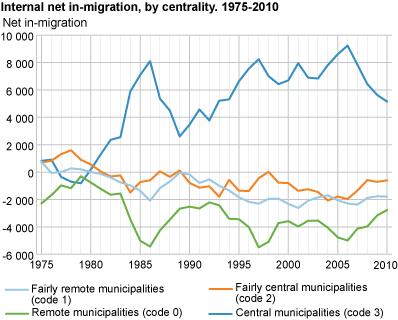Content
Published:
This is an archived release.
Much migration, but less centralisation
In 2010, following two years of somewhat lower rates of internal migration in 2008 and 2009, the migration was again back at the level of 2007. However, in spite of much migration, the rate of centralisation is decreasing.
During 2010 there were 214 700 migrations between Norwegian municipalities, which is the highest number ever registered. Adjusted for the size of the population, the mobility was higher until the mid 1970s, and was also higher for a couple of years in the middle of the 1980s and then again in 2000 and 2001. In addition to the high level of migration between municipalities, there were 408 700 migrations within municipalities, which is the highest number ever recorded.
The currents of migrations run between all parts of the country. The net effect of the migrations is a more centralised settlement pattern year by year, also in 2010. There are more people moving to the Oslo region and the other major city regions than in the opposite direction, and the northern and western parts of the country have a population loss every year, while the counties by the Oslo fjord have a net population gain.
Less centralisation
Even though the mobility is high, the rate of centralisation is slowing down for the fourth year in a row (figure 1). Not since the beginning of the 1990s has centralisation been slower. However, back then there was also less migration due to the bank crisis and a downward economic trend. Lately the centralisation has diminished in spite of an upward economic trend and high mobility.
| Municipality | Per 1 000 mean population |
Municipality | Number | ||||||||||||||||||||||||||||||||||||||||||||||||||||||||||||||||||||||||||||
|---|---|---|---|---|---|---|---|---|---|---|---|---|---|---|---|---|---|---|---|---|---|---|---|---|---|---|---|---|---|---|---|---|---|---|---|---|---|---|---|---|---|---|---|---|---|---|---|---|---|---|---|---|---|---|---|---|---|---|---|---|---|---|---|---|---|---|---|---|---|---|---|---|---|---|---|---|---|---|---|
| 1 | Berg | -26 | 1 | Sunndal | -118 | ||||||||||||||||||||||||||||||||||||||||||||||||||||||||||||||||||||||||||
| 2 | Hornindal | -28 | 2 | Bamble | -124 | ||||||||||||||||||||||||||||||||||||||||||||||||||||||||||||||||||||||||||
| 3 | Dovre | -29 | 3 | Førde | -137 | ||||||||||||||||||||||||||||||||||||||||||||||||||||||||||||||||||||||||||
| 4 | Gamvik | -29 | 4 | Vefsn | -156 | ||||||||||||||||||||||||||||||||||||||||||||||||||||||||||||||||||||||||||
| 5 | Måsøy | -31 | 5 | Tromsø | -175 | ||||||||||||||||||||||||||||||||||||||||||||||||||||||||||||||||||||||||||
| 6 | Verran | -32 | 6 | Flora | -184 | ||||||||||||||||||||||||||||||||||||||||||||||||||||||||||||||||||||||||||
| 7 | Utsira | -32 | 7 | Narvik | -227 | ||||||||||||||||||||||||||||||||||||||||||||||||||||||||||||||||||||||||||
| 8 | Salangen | -33 | 8 | Bergen | -400 | ||||||||||||||||||||||||||||||||||||||||||||||||||||||||||||||||||||||||||
| 9 | Fosnes | -35 | 9 | Stavanger | -723 | ||||||||||||||||||||||||||||||||||||||||||||||||||||||||||||||||||||||||||
| 10 | Vang | -35 | 10 | Oslo | -966 | ||||||||||||||||||||||||||||||||||||||||||||||||||||||||||||||||||||||||||
| Municipality | Per 1 000 mean population |
Municipality | Number | ||||||||||||||||||||||||||||||||||||||||||||||||||||||||||||||||||||||||||||
|---|---|---|---|---|---|---|---|---|---|---|---|---|---|---|---|---|---|---|---|---|---|---|---|---|---|---|---|---|---|---|---|---|---|---|---|---|---|---|---|---|---|---|---|---|---|---|---|---|---|---|---|---|---|---|---|---|---|---|---|---|---|---|---|---|---|---|---|---|---|---|---|---|---|---|---|---|---|---|---|
| 1 | Modalen | 34 | 1 | Ullensaker | 498 | ||||||||||||||||||||||||||||||||||||||||||||||||||||||||||||||||||||||||||
| 2 | Iveland | 25 | 2 | Fredrikstad | 497 | ||||||||||||||||||||||||||||||||||||||||||||||||||||||||||||||||||||||||||
| 3 | Vevelstad | 23 | 3 | Bærum | 373 | ||||||||||||||||||||||||||||||||||||||||||||||||||||||||||||||||||||||||||
| 4 | Skodje | 20 | 4 | Sarpsborg | 363 | ||||||||||||||||||||||||||||||||||||||||||||||||||||||||||||||||||||||||||
| 5 | Hvaler | 18 | 5 | Halden | 328 | ||||||||||||||||||||||||||||||||||||||||||||||||||||||||||||||||||||||||||
| 6 | Rennesøy | 17 | 6 | Skedsmo | 318 | ||||||||||||||||||||||||||||||||||||||||||||||||||||||||||||||||||||||||||
| 7 | Unjárga Nesseby | 17 | 7 | Os (Hordaland) | 260 | ||||||||||||||||||||||||||||||||||||||||||||||||||||||||||||||||||||||||||
| 8 | Ullensaker | 17 | 8 | Askøy | 259 | ||||||||||||||||||||||||||||||||||||||||||||||||||||||||||||||||||||||||||
| 9 | Bjerkreim | 16 | 9 | Eidsvoll | 258 | ||||||||||||||||||||||||||||||||||||||||||||||||||||||||||||||||||||||||||
| 10 | Os (Hordaland) | 15 | 10 | Ski | 255 | ||||||||||||||||||||||||||||||||||||||||||||||||||||||||||||||||||||||||||
Tables
- Table 1 All migrations. Internal movements and immigration. 1966-2010
- Table 2 Migration within and between counties and between counties and foreign countries. 2010
- Table 3 All migrations. Internal movements and immigration/emigration, by sex, age of migrants and county. 2010
- Table 4 Internal migration. 1951-2010
- Table 5 Internal migration, by county. 1966-2010
- Table 6 Net migration between counties. 2010
- Table 7 Migration within and between regions. 2010
- Table 8 Net migration between regions. 2010
- Table 9 Migration within municipalities, between municipalities, between counties and between regions, by the person's age and sex. Absolute figures and age-specific rates. 2010
- Table 10 Internal migration, by sex, marital status and 5-year age groups. 2010
- Table 11 Internal migration to and from the counties, by sex and age of migrant. 2010
- Table 12 Migration to/from counties and municipalities. 2010
- Table 13 Internal migration. In-migration, out-migration and net migration. Economic region. Migration between municipalities within the same economic region are included 2010
- Table 14 Migration within municipalities. 2010
- Table 15 Internal migration, by centrality of municipalities. Migration between municipalities with the same centrality are included. The whole country. 1996-2010
- Table 16 Internal netmigration to municipalities, by immigrant category, 2010
Contact
-
Statistics Norway's Information Centre
E-mail: informasjon@ssb.no
tel.: (+47) 21 09 46 42
-
Oppdrag befolkningsstatistikk
E-mail: befolkning@ssb.no
-
Even Høydahl
E-mail: even.hoydahl@ssb.no
tel.: (+47) 95 77 79 06

